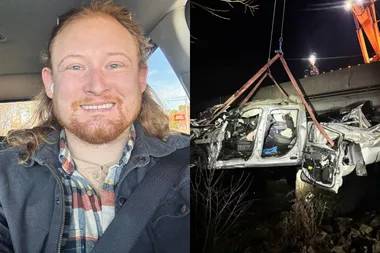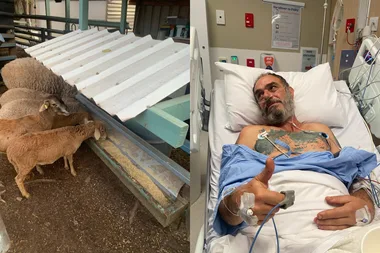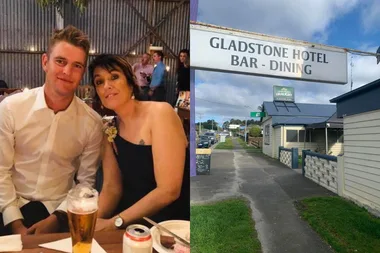A split-second decision changed Lyn’s life forever.
Here, Lyn, 57, tells the story in her own words.
Opening the door of a tattoo parlour, I saw a man getting inked in the chair. My little sister Rozelle, then 21, was about to get her first tattoo. ‘I’ll come along for moral support,’ I’d told her.
It was 1992 and I was 31 years old. While the tattooist finished a scroll design on the man, Rozelle sketched out a rosebud for the tattoo to go below her right hip. Then at the last minute, I decided to get inked too. After drawing a butterfly design, I jumped in the chair. ‘Because I’m the oldest, I’ll go first,’ I smiled to Rozelle.
As the tattooist scratched away on my right hip, it felt very painful and it bled a bit. Once it was finished, I saw the tattooist change the needle before starting on Rozelle’s design. A few days later, I went to Corsica, in France, where I worked as a tour guide and didn’t give the tattoo much more thought, unless I saw it while getting changed.

Then, eight weeks later, I became so ill I had to fly home to my parents. Feeling fluey, I couldn’t eat and had a high temperature. Sent to hospital by my GP, my condition deteriorated and I didn’t eat for two weeks. Despite doing many tests, they couldn’t find out what was wrong with me and I was sent home. I’d suffered an allergic reaction to penicillin so my whole body was covered in bumps. ‘Ugh,’ Rozelle said when she saw me. ‘Don’t worry, I haven’t got AIDS,’ I quipped. If only I knew…
Still not improving, I went back into hospital. ‘We need to eliminate everything,’ a nurse told me, explaining that they were testing for HIV. Well I won’t have that, I’m a woman, I thought naively. But when the nurse came in the next day, a terrible feeling washed over me. ‘I’ve got AIDS haven’t I?’ I asked, shaking.‘Yes, you’ve got six months to live,’ she said, bluntly.
I had HIV, the virus that leads to AIDS. Back then it was a certain death sentence. Sitting on my hospital bed in shock, I couldn’t believe what I’d just heard. I’m going to die, I thought. ‘Can I hug her?’ Mum asked the nurse. All my family knew about HIV was it was infectious and people died of it. Who gave it to me? I wondered.
Doing the right thing, Mum contacted all of my ex-partners and told them to get tested. Meanwhile, my health improved and I was well enough to leave hospital. I’m going to live life to the fullest I thought. Having lived in Sydney when I was 21, I booked a flight to go there to meet up with an estranged friend and visit family. ‘I need to make peace and say goodbye to everyone,’ I told Mum. ‘I’m dying,’ I’d tell people. But I didn’t feel like I was. I had no clue about what effect the disease would have on my body and doctors seemed uninformed too. Maybe one day I’ll just drop dead, I thought. But four months after the diagnosis, I still felt healthy.
As the years passed, I didn’t take any medication. My knowledge of the disease was limited, but I tried to live a healthy lifestyle. Then in 1996, I found out that I was pregnant with my then partner. Obviously, he knew of my status and we had taken what precautions we could. Will I pass it on to my baby? I worried. Doctors said they’d give me antiretroviral drugs a week before an enforced C-section. Afterwards, my baby would need to take them for three months and I wasn’t allowed to breastfeed. Thankfully my perfect little boy, Francois, now 20, didn’t have HIV and neither did his sister Amira, 17, who followed three years later.

Although by now I’d accepted I was HIV-positive, I still had no idea how I’d contracted it. None of my previous partners had come forward to say they’d been diagnosed and it remained a mystery. So, in 1998 I went to see a specialist.‘It takes eight weeks for the disease to attack the white blood cells,’ he said. Looking at a calendar, we tracked back to what had happened eight weeks before I fell ill in France. The tattoo, I realised. The needle mustn’t have been changed. I’d been very unlucky but it was the only explanation. I couldn’t torture myself, but I felt aggrieved that a split-second decision had completely altered my life.
In 2000, I decided to try and dispel the myths surrounding HIV and AIDS. Educating myself on the disease, I realised most other people didn’t know a lot about it either. So I started the fashion event StyleAid to raise money for women and children with HIV. Many people still think it’s a ‘gay man’s disease’ but that simply isn’t true. I’m a woman and it happened to me. Anyone can get HIV or AIDS and it’s important for people to take precautions.
Today, I lead a healthy lifestyle and take three tablets daily to keep my HIV at bay. HIV and AIDS isn’t the death sentence it used to be, but we should still be vigilant.I encourage people to get tested. There’s nothing to be ashamed of and it might just save your life.

Read more in this week’s issue of that’s life!
 Amanda Bransgrove
Amanda Bransgrove









